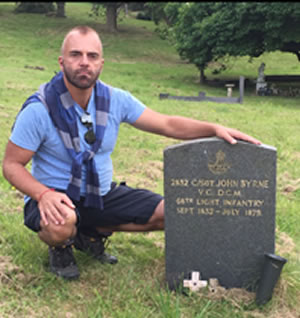Tobias Neto discovered a Victoria Cross in Thames mud
 |
|
Putney resident and member of PutneySW15.com Tobias Neto has enjoyed mudlarking for the past two years and take his metal detector to the foreshore three to five times a week, depending on his schedule and, of course, the tides.
He told this website:
"It's a hobby that keeps me healthy and teaches me a whole new world of history. On the 17th December 2015, whilst detecting on my usual area (I prefer not to disclose the area ) on the Thames foreshore, I came across what looked at first like a large brooch or medal, about 3 inches deep. It was covered in mud. I kept it and carried on detecting. Only when I got home did I realise I had a VC medal in my hands ( I could read the writing "FOR VALOUR" below the crown). Eventually I noticed the date on the reverse: 5 NOV 1854."
Tobias had already made some interesting finds:
"Previously I had found important historical artifacts such as a 13th century Pilgrim badge, a syringe to treat syphilis from the 18th century, Elizabeth I, Charles I, & II hammered coins, Roman coins and even a Quarter Stater Celtic coin dated 40 AD."
But the VC tops the lot. When he reported his find, he was told by the Museum of London's Finds Liaison Officer, Ms Kate Sumnall;"Do you realise you have the find of a lifetime? You might be the only person in the world to have found a VC medal. "
The Victoria Cross is the highest and most prestigious award for gallantry in the face of the enemy that can be awarded to British and Commonwealth forces.
Tobias' research began and whilst sixteen Victoria Crosses were awarded to British soldiers on the 5th November 1854 after the Battle of Inkerman (a battle fought during the Crimean War between the allied armies of Britain, France and Ottoman Empire against the Imperial Russian Army), he discovered that
there are only two names of unknown VC medals linked to the Crimean War in 1854; these were Sergeant John Byrne, originally from Castlecomer, County Kilkenny, Ireland and Private John McDermond, originally from Clackmannan, Scotland. The other fourteen are accounted for in museums and private collections.

Tobias Neto at the burial place of Sergeant John Byrne
Tobias' gut feeling is that the medal belongs to Sergeant John Byrne:
"I discovered Sergeant John Byrne's burial place and decided to visit his headstone at the St Woolo's Cemetery, Newport, Wales. He's been from day one my number one suspect and that was the main reason of my visit. I've always thought the medal belonged to him."
At the time of the battle John Byrne was a private and twenty two years old, he was awarded the medal for his actions when his regiment was ordered to retire, he went back towards the enemy, and, at the risk of his own life, brought in a wounded soldier, under fire.
McDermond was also a private and approximately twenty two years old, he and Captain Hugh Rowlands saved the life of a Colonel Haly who was lying wounded on the ground surrounded by the enemy. Private McDermond rushed to the rescue and killed the man who had wounded the colonel.
Both soldiers survived the Crimean War to fight and be decorated in other campaigns. According to Wikipedia Private Byrne won a Distinguished Conduct Medal during the Tauranga campaign in New Zealand in 1864, and Private McDermond won the Médaille militaire (French Military Medal).
The reason the ownership is not known is that although the date of the battle is on the reverse of the cross the name of the recipient would be engraved on the suspender bar which is missing - Tobias continued to search for this in the mud of the Thames.
Tobias said:
"I'm very grateful to the MoL support with the research. Now the VC medal will be on display at the MoL from Thursday 10th November 2016 for 6 weeks, some 160 years since when it was first created by Queen Victoria in 1856."
November 13, 2016